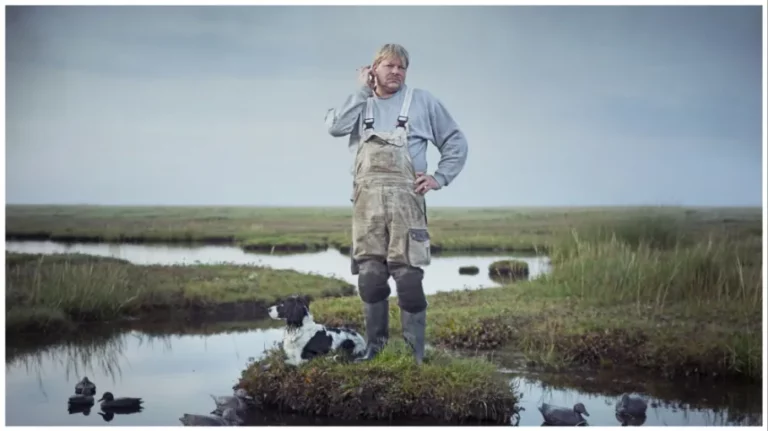Due to world premiere in IDFA’s international competition program on Monday, the Danish doc “As the Tide Comes In” is a collaborative work between Basque-born director Juan Palacios (“Meseta,” “Pedaló”), and the team behind the multi-awarded film “The Lost Leonardo”: Sofie Husum Johannesen, making her debut here as co-director, Andreas Dalsgaard, acting as executive producer and idea initiator, editor Nicolas Nørgaard Staffolani and producer Kasper Lykke Schultz.
With their shared anthropological perspective, the filmmaking team have captured the extraordinary life of the 27 residents of the tiny Danish Wadden Sea island of Mandø, which can only be reached at low tide. The islanders – including Gregers, the only farmer and youngest of all – are stoically fighting off severe weather conditions and the risk of flooding, like survivors of a doomed refuge, waiting for the inevitable catastrophe to happen. “It is a metaphor for where we are as human beings and the challenges that we’re facing with climate change,” says Palacios about his observational pic, sparkled with humorous touches, such as in the main character’ introductory scene, where we see him trying to enter TV2 Denmark’s reality show “Farmer Wants a Wife.”
The film has an unusual starting point, as you were actually approached by Elk Film’s co-founder Andreas Dalsgaard to direct it. How did you react to this offer?
I was honored as no one had asked me to direct a film before. I had always been the initiator of my own projects. Andreas had seen my previous film “Meseta” (“Inland”), which picked up a prize at CPH:DOX in 2019, and I guess he liked it enough to approach me. The idea was to make a film at Mandø, where I would use my sensitivity displayed in my previous work.

Had you ever heard about Mandø before and what struck you about the place in the middle of the UNESCO World Heritage’s Wadden Sea?
No I had never heard about it before, although I was aware of the Wadden Sea, having lived in Denmark for 10 years. Then coming from the Basque country in Spain, I was familiar with the effects of tides on coastal areas. That said, Mandø was still an incredibly exotic place for me. What struck me was the flatness of the landscape, the water and land intersecting and creating a Sahara-like endless horizon. It’s surreal. In fact next to Mandø is the Korsesand sandbank considered as a desert.
As shown in the film, a lot of tourists visit that place in the summer, attracted by its beauty, its unicity as a bird paradise, its “funky” element as a tiny place home to only 27 people. At the same time, there is an elusive sense of danger there, with the threatening sea changing with the wind and tide, and storms always brewing. That creates a sense of thrill for visitors.
How was your collaboration with Sofie Husum Johannesen, credited as your co-director?
We made the film together although she didn’t direct it as such. Sofie is a visual anthropologist, therefore she brought her sensitivity about and understanding of human behavior and how societies work. Being Danish, she also has a natural cultural baggage that I lack. She did a lot of research and spent a couple of weeks on her own on the island at the beginning, to get to know the residents. It was a manageable number with 27 of them! She collected their stories and then we discussed which ones were most suitable to capture the essence of Mandø. Sofie totally helped me navigate the reality of the island and gained people’s trust. Being from that remote corner of Denmark, most of them just wanted to be listened to.
Why did you choose the farmer Gregers as your main character?
First of all, he is the youngest still on the island – although in his 40s. In that sense, he is the last “hope” for a Mandø resident to build a family and a future there. Secondly, there is a true sense of pride, of belonging in him. Unlike most people his age who left, he is determined to stay and is actively looking for a wife to live with him in Mandø. He loves the island but resents it at the same time. He has inherited the farm from his parents but the family legacy is a heavy weight to carry.

Your film is a double narration-one being the portrait of Gregers and the other islanders, their daily lives and conversations that inform us on Mandø’s past and present. Then there is the island itself, shaped by the seasons and threatened by the hostile nature. How much material did you gather to come to this final result, and what were the biggest challenges in creating this narrative structure?
Well, keeping this apparent simplicity was one of the main challenges. We did not film that much, but we did extensive writing. Due to Mandø’s reality, which is very limited, nothing much happened spontaneously, therefore we had to intervene, for instance create a framework for the conversations and let people speak spontaneously within that space. That planning required knowing the people well to anticipate a bit how they would react to the encounters and our cinematic device.
Could you expand on your visual style, how hard it was to find the right locations and perfect light?
Again, there was a lot of writing involved. I worked with the place as the main subject in a way. For me, directing and cinematography are hard to separate, so I planned a lot – where to place the camera, at what time of the day. Every time I would go to the island – which was 15 times over three years – I would drive to places on a location recce to identify the spots, map the place at different times of the year. Visually, I wanted to capture the looming danger, using the landscape but also technology used by humans to understand the forces of nature. Like a ticking clock. Then to highlight the flat landscape, we filmed very wide, in scope.
How was this almost ‘out of time and out of space’ experience for you on Mandø?
It was like when you see a rare bird – you see a glimpse of it, and it feels like… wow it’s beautiful! I feel privileged to have had access to the island, the residents’ unique stories that are so different from me, from modern life. It humbled me.
What do you wish viewers will take away from watching the film?
Well, it’s always hard for me, as I’m not making films to deliver a message. I follow stories, processes that I’m attracted to, hoping people will see what I saw in them. That said, the film is a metaphor for where we are as human beings and the challenges that we’re facing with climate change. This film is an invitation to reflect on this major issue.
![]() Post Views: 2,777
Post Views: 2,777

